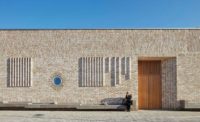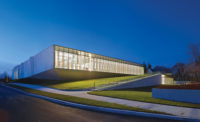Sydney’s central business district is studded with skyscrapers by international architecture firms, including Renzo Piano Building Workshop’s Aurora Place (2000), Foster + Partners’ Deutsche Bank Place (2005), and Rogers Stirk Harbour + Partners’ 8 Chifley (2013). The work of these big guns from abroad is so pervasive that it’s almost unusual to see a high-rise development led by Australian architects. Not far from Sydney Cove, the compact bay that connects Jørn Utzon’s Opera House and the Harbour Bridge, a new building by Sydney-based fjmt has been designed to show the strength of going local, not global. Fjmt’s design director, Richard Francis-Jones—whose studio won the World Architecture Festival’s World Building of the Year in 2013 for its work on the Auckland Art Gallery—predicated his firm’s competition-winning scheme on demonstrating a rich Australian sense of place, a counterpoint to the bland globalized homogeneity of glass-and-steel office towers. The EY Centre isn’t the tallest building in the district—its height was limited by a requirement for sunlight access for a nearby square. But in a downtown dominated by high-rise buildings of cool gray stone and dark glass, fjmt’s 37-floor, 509-foot-tall building is a surprising shot of warmth: a curvaceous, organic form lined top-to-bottom with timber blinds that glow golden in the bright Australian sunlight from behind a single pane of clear, low-iron glass.
Additional Content:
Jump to credits & specifications
The EY Centre’s sleek assembly of two intersecting vertical and rectangular volumes, with curved edges and a four-story podium, occupies a site on George Street, one of the city’s most important boulevards. It features a brass strip that runs across the ground floor and a new plaza to mark the 1780 shoreline of Sydney Harbour. The indigenous Gadigal clan and Australia’s first colonial settlers used the now-buried Tank Stream that once ran beside the site as a freshwater source; the shoreline was fringed with eucalyptus trees, the inspiration behind the marine ply panels on the podium’s vertical fins, street awning, and lobby ceiling.
Francis-Jones was determined that the building would look and feel distinctive, and that it would be a good citizen of the city. “Towers usually just crush their sites through sheer scale,” he says. Instead of gobbling its site at ground level, the EY Centre’s podium peels away to create the new plaza. From there, steps emulating the original contour of the land lead down to an intimate courtyard with a slim, curvaceous kiosk and a series of laneways previously inaccessible from this part of George Street. Elegant white steel-and-concrete V-columns support the part of the tower that overhangs the plaza, providing shade from the scorching summer sun.
Visitors to Sydney will be familiar with the honeyed hues of the sandstone, known as Yellow Block, used in the construction of many of the city’s stately Victorian buildings. At the EY Centre, sandstone was quarried from the site during excavation and now clads the elevator core, creating the impression that the building’s reinforced-concrete structure has actually been fashioned from the stone below. In the lobby, this sandstone is the basis of a dramatic 3,200-square-foot artwork by indigenous artist Judy Watson. Other buildings on George Street have grand artworks in their lobbies by Sol LeWitt and Frank Stella; it seems fitting that this building, in its aspirations to create a truly Australian sense of place, puts an indigenous Australian woman artist on an equal footing with these American men.
For all this generosity at ground level, it is what happens upstairs that is the building’s real talking point. Some people who have not been inside have asked why anyone would cover the spectacular view of the Sydney Harbour Bridge and Opera House with blinds, but the blinds are controlled by an algorithm and are only closed for part of the day. When the sun is shining from the west, the blinds to the east and south are usually open, so that there is always a vista of somewhere (the building’s offset core means that even the bathrooms have windows with views). When the blinds are closed, plenty of daylight still gets in, and the occupants see the timber screen suffused with a golden glow.
The closed-cavity facade and timber blind system is an Australian first that required extensive research and development. The exterior of the building is comprised of a single sheet of clear low-iron glass in front of a sealed, dust-free pressurized cavity containing the timber blinds (the cavity’s edges are also lined with wood). Behind this is a layer of double-glazed high-performing insulated glass. The cavity containing the blinds heats up in the summer sun, but excess heat is emitted straight back through the single exterior pane, and the double-glazed pane is never in direct sunlight.
The facade system has a solar heat gain coefficient of 0.11, making its thermal performance 35 percent better than that of a more standard curtain wall assembly. The sophisticated skin works in conjunction with such features as hybrid chilled beams, an all-LED lighting scheme, and an advanced energy-monitoring system to earn the EY Centre six stars under Australia’s green building certification program—the highest rating possible.
The building’s developer and builder, Mirvac, moved its head office to the EY Centre after completion in 2016 (other occupants include EY, a business consultancy and the primary tenant, and AGL, an electricity and gas company). Since then, Mirvac has been surveying the satisfaction of its employees. Staff have reported a 50 percent increase in their sense of “spatial comfort,” a particularly impressive response given that the old headquarters had 129 square feet of space per person; there are only 86 square feet of space per person in the EY Centre. Most gratifying for the architects, the staff’s sense of connection to the outdoor environment has increased 41 percent, making it that much harder to mistake the EY Centre for a product of any other place.
CreditsArchitect: Francis-Jones Morehen Thorp (fjmt) Address: Level 5/70 King St, Sydney NSW 2000 Phone: +610292517077
Personnel in architect's firm who should receive special credit: Richard Francis-Jones, Johnathan Redman, Soenke Dethlefsen, Peter Dawson, Steven Wu, Natalie Fan, Martin Hallen, Pray Mathur, Stephen Pratt, Owen Sharp, Daniel Karamaneas, Richard Desgrand, Richard Tripolone, Chris Roberts-Brewer, Matthew Todd
Architect of record: Richard Francis-Jones
Interior designer: Interior design for the foyer: fjmt Interior Fit-out of Mirvac HQ: Davenport Campbell Interior Fit-out of EY floors: Hassell
Engineers: Civil, Structural: BG&E Mechanical, Hydraulic, Fire, ESD, Vertical Transport: Arup MEP: Arup
Consultants: Town Planning: JBA Planning Pty Ltd Fire Sprinklers: DP Consulting Façade: Surface Design Pty Ltd Façade: Permasteelisa Geometry: AR-MA BIM: fjmt Wind: CPP Wind Engineering & Air Quality Consultants Heritage: Godden Mackay Logan Pty Ltd Artist: Judy Watson Artist: Michael McIntyre Acoustic: Renzo Tonin Geotechnical: Coffey Geotechnics Pty Ltd Traffic: Colton Budd Hunt and Kafes Principal Certifying Authority: Advance Building Approvals Pty Ltd Accessibility: Morris Goding Accessibility Consulting (MGAC) Independent Commissioning Consultant: Engineering Commissioning Services Access: Meld Strategies Energy Concept: Climatech Group Energy Concept: Arup Land Surveyor: Rygate & Company Pty Limited
General contractor: Mirvac Constructions Pty Limited
Photographer: John Gollings, Brett Boardman, Demas Rusli, Gareth Hayman, Mark Merton, Rodrigo Vargas, Owen Sharp |
SpecificationsExterior Cladding Masonry: Blockwork: Boral Metal panels: Composite Aluminium Cladding:Alucobond Wood: Austral Marine Plywood: Austral Curtain wall: CCF facade: Permasteelisa
Interior Finishes Suspension grid: Blue Tongue 2 way grid suspension system:Armstrong Resilient flooring: Marmoleum Real:Forbo Carpet: Equilibrium II:Interface
Furnishings Reception furniture: Capisco Chair:HAG Chairs:Cowrie Chair in Walnut Plywood by Brodie Neill Tables: Foyer tables by Shelby Stone Upholstery: Foyer benches by HDallas
Conveyance Elevators/escalators: Schindler |

















Post a comment to this article
Report Abusive Comment